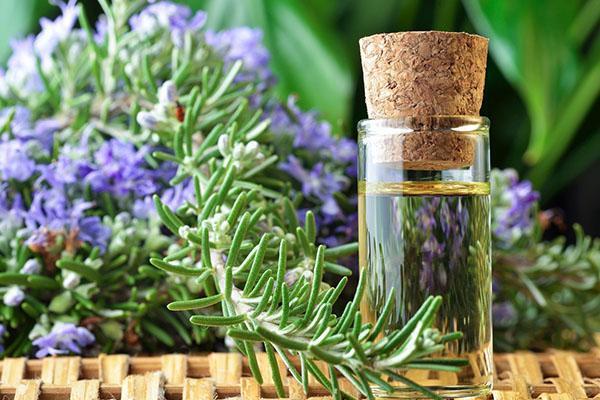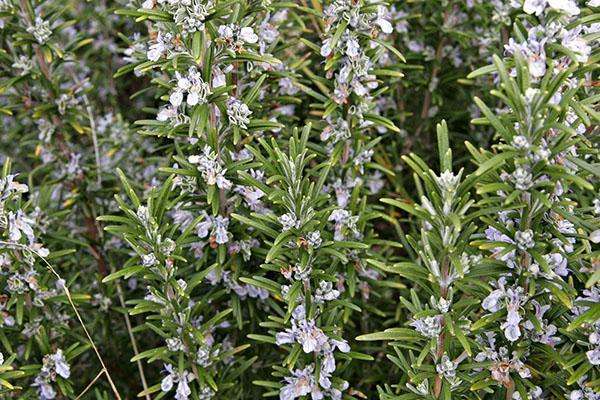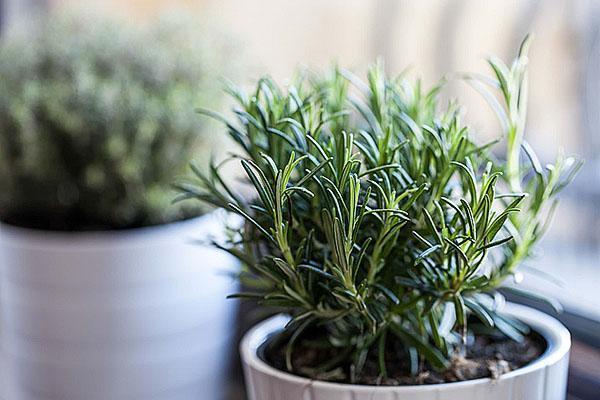Spices on the windowsill all year round, or how to grow rosemary at home in a pot
 Fans of pharmaceutical gardens and natural spices in cooking should pay attention to rosemary. Growing a house in a pot will require knowledge of the characteristics of this plant, but as a result, you will be provided with valuable gingerbread herbs all year round. Rosemary leaves, shoots and flowers contain essential oil with unique beneficial properties. An infusion and decoction of rosemary is used for headaches, stomach problems, colds, women's diseases, as a tonic in case of loss of strength.
Fans of pharmaceutical gardens and natural spices in cooking should pay attention to rosemary. Growing a house in a pot will require knowledge of the characteristics of this plant, but as a result, you will be provided with valuable gingerbread herbs all year round. Rosemary leaves, shoots and flowers contain essential oil with unique beneficial properties. An infusion and decoction of rosemary is used for headaches, stomach problems, colds, women's diseases, as a tonic in case of loss of strength.
Fresh and dried leaves are widely used for flavoring confectionery, olive oil, vinegar, alcoholic beverages. The unique coniferous aroma of rosemary with bitter citrus notes will turn any dish made from vegetables, meat or fish into a culinary masterpiece. And all of this is easily provided by one rosemary bush in a pot on your windowsill. It remains to learn more about this ancient culture.
Description of the plant

This plant does not belong to indoor plants, so to grow rosemary at home in a pot, it is better to purchase a young seedling in a specialized store.
What conditions do rosemary need
 For successful breeding of this culture, you need to know the conditions of its growth and try to recreate them at home. It:
For successful breeding of this culture, you need to know the conditions of its growth and try to recreate them at home. It:
- strong lighting;
- low temperature without sharp drops;
- fresh air;
- lack of drafts;
- moderate humidity.
In central heating conditions, the plant needs regular spraying, as it begins to shed leaves in dry air.
Planting rosemary
 Rosemary has a branched root system. A large clay pot is suitable for this. The pottery does not heat up in the sun and maintains the optimum temperature of the root system. Drainage from small fractions of expanded clay, broken shards, pebbles is laid at the bottom of the pot. The drainage height can be up to a quarter of the pot height. On top of it, a small layer of vermiculite will be useful, which perfectly regulates the moisture of the earthy coma.
Rosemary has a branched root system. A large clay pot is suitable for this. The pottery does not heat up in the sun and maintains the optimum temperature of the root system. Drainage from small fractions of expanded clay, broken shards, pebbles is laid at the bottom of the pot. The drainage height can be up to a quarter of the pot height. On top of it, a small layer of vermiculite will be useful, which perfectly regulates the moisture of the earthy coma.
The soil for growing rosemary in a pot should be light, well-structured and contain a large amount of coarse sand, fine gravel; neutral or slightly alkaline reaction. It is prepared from the following components:
- 1 part of sod land;
- 1 part peat;
- 1 part coarse sand or vermiculite.
Since peat has an acidic reaction, ash is added to alkalize the soil.
 A little soil is poured on top of the drainage so that the root collar is slightly below the sides. The plant is placed on the ground, the roots are straightened and carefully sprinkled with earth along the edges of the container. The soil is lightly compacted and watered to settle.
A little soil is poured on top of the drainage so that the root collar is slightly below the sides. The plant is placed on the ground, the roots are straightened and carefully sprinkled with earth along the edges of the container. The soil is lightly compacted and watered to settle.
A few days after planting, you should add some more soil so that the roots do not bare.
Young plants are transplanted annually in early spring, then once every two years.
Caring for rosemary in a pot
 In order for rosemary to bloom in a pot at home in spring, it is important to provide it with a dormant period. In winter, the most suitable temperature for it is 10-13 ° C. The bush is moderately watered with settled water, do not forget to spray and keep on a sunny windowsill. In the spring, after transplanting, when the seedling starts to grow, the irrigation rate is increased and they begin to feed it once every two weeks with complex mineral fertilizers.
In order for rosemary to bloom in a pot at home in spring, it is important to provide it with a dormant period. In winter, the most suitable temperature for it is 10-13 ° C. The bush is moderately watered with settled water, do not forget to spray and keep on a sunny windowsill. In the spring, after transplanting, when the seedling starts to grow, the irrigation rate is increased and they begin to feed it once every two weeks with complex mineral fertilizers.
During the growing season, a pot of rosemary is taken out to the balcony, loggia, or transported to the country. On cold nights, it is advisable to bring it into the house, since rosemary does not like sudden changes in temperature.
Rosemary pests and diseases
This plant is quite resistant to various diseases and pests. However, with high dry air on the stems and leaves, subtle cobwebs may appear - this is a spider mite. With a small lesion, soapy water will help, with which the entire aerial part of the bush is moistened. If the tick has managed to multiply strongly, any insecticide - "Fitoverm" or "Actellik" will help.
With insufficient watering, the lower leaves of rosemary begin to turn yellow, and with excessive watering, they fall off. Bringing the watering schedule back to normal will eliminate these symptoms.
If you follow these simple rules, growing rosemary at home in a pot will turn into an exciting experience, and a caring owner will be rewarded with more fragrant spicy leaves for preparing delicious dishes and maintaining health without pills.